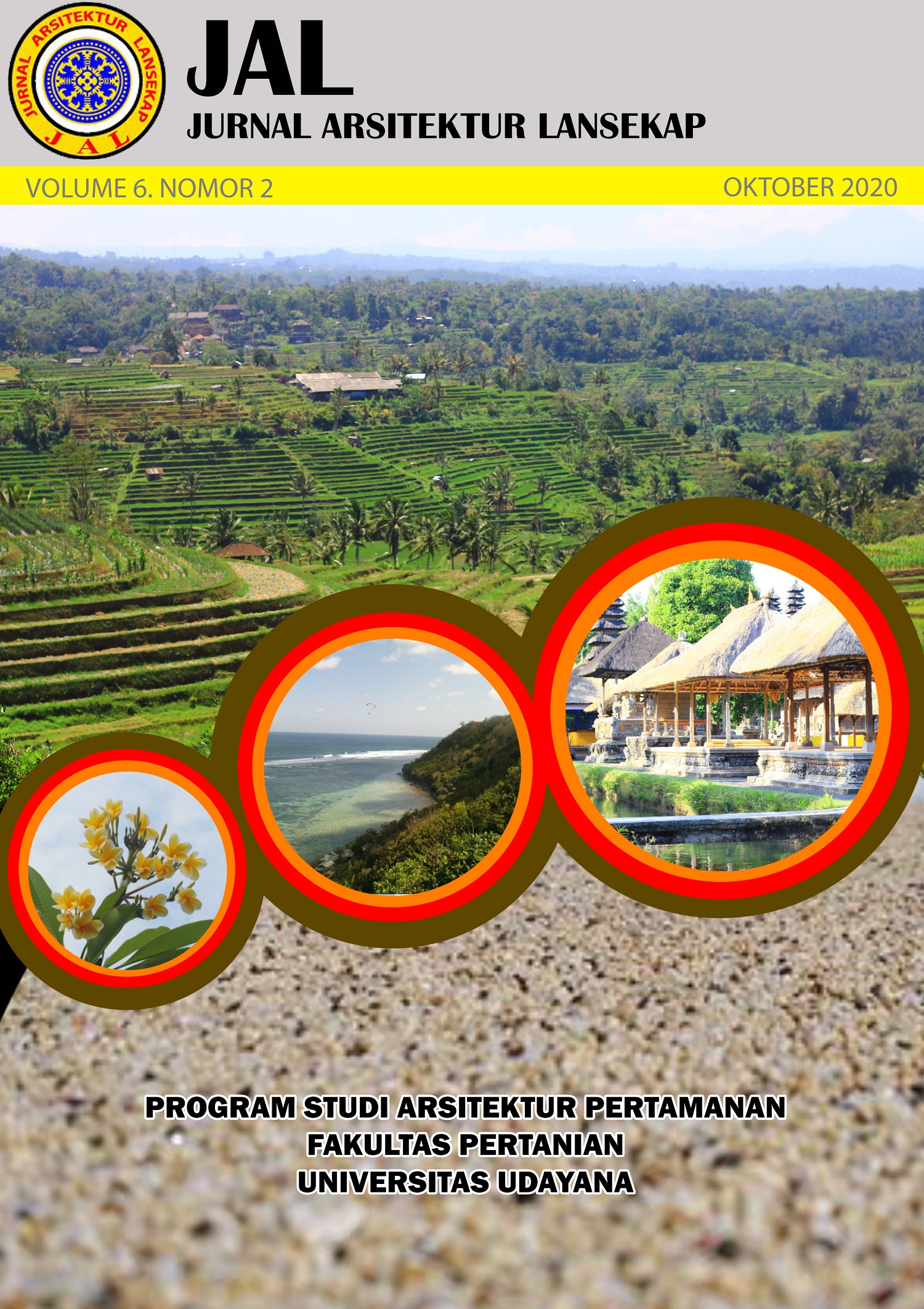Karakter pengunjung dan radius layanan taman kota:studi kasus Taman Puputan Badung I Gusti Ngurah Made Agung, Denpasar
Abstract
City Park Service Distance: Case Study of Puputan Badung I Gusti Ngurah Made Agung Denpasar Park. This research is a preliminary work on finding out how a park has been functioned as a public facility to a city. It is aimed to find out Lapangan Puputan Badung service distance range as one of Denpasar city parks. Moreover, it is also to find out the characteristic uses of the park by its users. This case study uses a survey research method. Sample of respondents are chosen using accidental sampling technique with questionnaire as media of data collection. Research findings are analyzed spatially and descriptively as well. Result shows that most samples live within 5 km range from the park. The park has been used mostly for recreation and exercises. People within productive age have been dominated the use of the park. Duration people spend in the park is between 1 – 2 hours, however there is an interesting finding that 15% samples say that they spend 3 – 4 hours in the park. There is also a strong tendency that people uses the park as a group, meaning they might be there with family, relatives, or friends. More than 50% of user respondents are the park frequent
visitors. As conclusion, it can be stated that Lapangan Puputan Badung function the best to serve the dwellers within 5 km radius.
Downloads
References
Mani, N.P.A.C., G.M. Adnyana, N. Kohdrata. 2012. Studi Home Range Penggunaan Taman Kota: Studi kasus Lapangan Puputan Margarana Niti Mandala, Denpasar, Bali. E-Jurnal Agroekoteknologi Tropika, volume 1 nomor 2, Oktober 2012. Program Studi Agroekoteknologi Fakultas Pertanian Universitas Udayana.
Nursanto, Ali. 2011. Analisa Taman Menteng sebagai Taman Kota Berdasarkan Kriteria Kualitas Taman Jakarta Pusat. Jurnal Planesa, volume 2 nomor 1, Mei 2011. Hal: 10-16. Universitas Esa Unggul.
Peraturan Menteri Pekerjaan Umum Nomor 5 tahun 2008 tentang Pedoman Penyediaan dan Pemanfaatan Ruang Terbuka Hijau di Kawasan Perkotaan. Dirjen Penataan Ruang Departemen Pekerjaan Umum.
Riana, I N., Widiastuti, I.B.G. Primayatna. 2014. Kajian Alih Fungsi Ruang Terbuka Hijau di Kota Denpasar. Ruang-Space: Jurnal Lingkungan Binaan, volume 1 nomor 1, April 2014. Hal: 85-98. Program Studi Magister Arsitektur Universitas Udayana.
Suryana, I Gede Putra Eka. 2014. Analisis Ketersediaan Ruang Terbuka Hijau dan Indeks Kenyamanan (Kasus Kota Denpasar Provinsi Bali Periode Tahun 2003 dan 2013). Tesis Program Studi S-2 Geografi Fakultas Geografi Universitas Gadjah Mada (tidak dipublikasi).
Travlou, P. 2007. Mapping Youth Spaces in the public realm: identity, space and social exclusion. Dalam Open Space – People Space. C.W. Thompson and P. Travlou (editor). Taylor & Francis e-Library.
Undang-Undang Republik Indonesia Nomor 26 tahun 2007 tentang Penataan Ruang.
Worpole, K. 2007. The Health of the People is the Highest Law: Public health, public policy, and green space. Dalam Open Space – People Space. C.W. Thompson and P. Travlou (editor). Taylor & Francis e-Library.
An author who publishes in the Jurnal Arsitektur Lansekap (JAL) agrees to the following terms:
- Author retains the copyright and grants the journal the right of first publication of the work simultaneously licensed under the Creative Commons Attribution-ShareAlike 4.0 License that allows others to share the work with an acknowledgement of the work's authorship and initial publication in this journal
- Author is able to enter into separate, additional contractual arrangements for the non-exclusive distribution of the journal's published version of the work (e.g., post it to an institutional repository or publish it in a book) with the acknowledgement of its initial publication in this journal.
- Author is permitted and encouraged to post his/her work online (e.g., in institutional repositories or on their website) prior to and during the submission process, as it can lead to productive exchanges, as well as earlier and greater citation of the published work (See The Effect of Open Access).
Read more about the Creative Commons Attribution-ShareAlike 4.0 Licence here: https://creativecommons.org/licenses/by-sa/4.0/.







